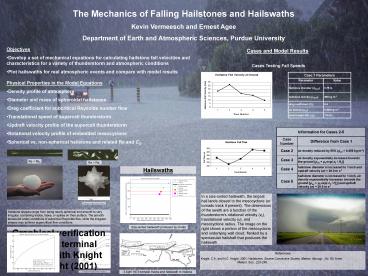The Mechanics of Falling Hailstones and Hailswaths - PowerPoint PPT Presentation
1 / 1
Title:
The Mechanics of Falling Hailstones and Hailswaths
Description:
The Mechanics of Falling Hailstones and Hailswaths Kevin Vermeesch and Ernest Agee Department of Earth and Atmospheric Sciences, Purdue University – PowerPoint PPT presentation
Number of Views:10
Avg rating:3.0/5.0
Title: The Mechanics of Falling Hailstones and Hailswaths
1
The Mechanics of Falling Hailstones and
Hailswaths Kevin Vermeesch and Ernest
Agee Department of Earth and Atmospheric
Sciences, Purdue University
- Objectives
- Develop a set of mechanical equations for
calculating hailstone fall velocities and
characteristics for a variety of thunderstorm and
atmospheric conditions - Plot hailswaths for real atmospheric events and
compare with model results - Physical Properties in the Model Equations
- Density profile of atmosphere
- Diameter and mass of spheroidal hailstones
- Drag coefficient for subcritical Reynolds number
flow - Translational speed of supercell thunderstorm
- Updraft velocity profile of the supercell
thunderstorm - Rotational velocity profile of embedded
mesocyclone - Spherical vs. non-spherical hailstone and related
Re and CD
Cases and Model Results
Cases Testing Fall Speeds
Case 1 Parameters Case 1 Parameters
Parameter Value
hailstone diameter (dstone) 0.75 in
hailstone density (?stone) 900 kg m-3
drag coefficient (CD) 0.5
air density (?air) 0.900 kg m-3
initial height AGL (z0) 7.0 km
Information for Cases 2-5 Information for Cases 2-5
Case Number Difference from Case 1
Case 2 air density reduced by 50 (?air 0.450 kg m-3)
Case 3 air density exponentially increases towards the ground ?air ?0 exp(-z0 / H?)
Case 4 hailstone diameter is increased to 1 inch and updraft velocity (w) 20.0 m s-1
Case 5 hailstone diameter is increased to 1 inch, air density exponentially increases towards the ground ?air ?0 exp(-z0 / H?) and updraft velocity (w) 20.0 m s-1
Re lt Rec
Re gt Rec
Hailswaths
In a size-sorted hailswath, the largest hail
lands closest to the mesocyclone (or tornado
track if present). The dimensions of the swath
are a function of the thunderstorms rotational
velocity (v?), translational velocity (u), and
mesocyclone radius. The image on the right shows
a portion of the mesocyclone and underlying wall
cloud, flanked by a spectacular hailshaft that
produces the hailswath.
Knight and Knight (2005), Figure 9
Hailstone shapes range from being nearly
spherical and smooth to very irregular,
containing knobs, lobes, or spikes on their
surface. The smooth stones fall under conditions
of subcritical Reynolds flow, while the irregular
shapes may achieve supercritical flow conditions.
Size-sorted hailswath produced by model
Graphical verification of model terminal velocity
with Knight and Knight (2001)
References Knight, C.A. and N.C. Knight, 2001
Hailstorms. Severe Convective Storms, Meteor.
Monogr., No. 50, Amer. Meteor.
Soc., 223-249. Knight, C.A. and N.C. Knight,
2005 Very large hailstones from Aurora,
Nebraska. Bull. Amer. Meteor. Soc., 86,
1773-1781.
3 April 1974 tornado tracks and hailswath in
Indiana
Knight and Knight (2001), Figure 6.2

